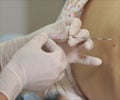Anesthetizing an arm affects brain activity and rapidly impairs body perception, scientists have demonstrated.

The ultimate aim was to understand how neuronal circuits are reorganised at this exact moment in time and to take advantage of anaesthesia to reconfigure them correctly following trauma.
This would allow anaesthetic techniques to be used in the future to treat pain described by amputated patients in what are known as 'phantom limbs'.
The researchers wanted to discover whether anaesthesia could induce comparable phenomena in the brain. If so, anaesthetics could be used as new therapeutic tools capable of modulating brain activity.
They monitored 20 patients who were to have one of their arms anaesthetised before surgery.
The patients were shown 3D images of the hand, shot from different angles, and their ability to distinguish the right hand from the left was assessed.
Advertisement
The researchers found that all the patients described false sensations in their arm.
They found that the best results were obtained when the anaesthetised limb was visible.
Anaesthetising the hand (peripheral deafferentation ) modifies brain activity and rapidly changes the way we perceive the outside world and our own body, concludes the researchers.
The team is now using functional brain imaging to characterise the regions concerned in the brain.
The work will be published in the journal Anesthesiology.
Source-ANI











